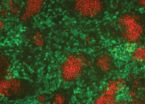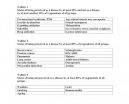Gap between present emissions and the 2-degree target
2012-12-03
(Press-News.org) Carbon dioxide emission reductions required to limit global warming to 2°C are becoming a receding goal based on new figures reported today in the latest Global Carbon Project (GCP) calculations published today in the advanced online edition of Nature Climate Change.
"A shift to a 2°C pathway requires an immediate, large, and sustained global mitigation effort" says GCP executive-director and CSIRO co-author of the paper, Dr Pep Canadell.
Global CO2 emissions have increased by 58% since 1990, rising 3% in 2011, and 2.6% in 2012. The most recent figure is estimated from a 3.3% growth in global gross domestic product and a 0.7% improvement in the carbon intensity of the economy.
Dr Canadell said the latest carbon dioxide emissions continue to track at the high end of a range of emission scenarios, expanding the gap between current trends and the course of mitigation needed to keep global warming below 2°C.
He said on-going international climate negotiations need to recognise and act upon the growing gap between the current pathway of global greenhouse emissions and the likely chance of holding the increase in global average temperature below 2°C above pre-industrial levels.
The research, led by Dr Glen Peters from CICERO, Norway, compared recent carbon dioxide emissions from fossil fuel combustion, cement production, and gas flaring with emission scenarios used to project climate change by the Intergovernmental Panel on Climate Change (IPCC).
"We need a sustained global CO2 mitigation rate of at least 3% if global emissions are to peak before 2020 and follow an emission pathway that can keep the temperature increase below 2˚C", Dr Peters said.
"Mitigation requires energy transition led by the largest emitters of China, the US, the European Union and India".
He said that remaining below a 2°C rise above pre-industrial levels will require a commitment to technological, social and political innovations and an increasing need to rely on net negative emissions in future.
### The Global Carbon Project, supported by CSIRO and the Australian Climate Change Science Program, generates annual emission summaries contributing to a process of informing policies and decisions on adaptation, mitigation, and their associated costs. The summaries are linked to long-term emission scenarios based on the degree of action taken to limit emissions.
ELSE PRESS RELEASES FROM THIS DATE:
2012-12-03
DOHA, QATAR (2 December 2012)_Forestry experts have called for a new approach to managing land and tackling climate change – challenging the ongoing debate that forests have to be sacrificed for the sake of rural development and food security.
Governments, policymakers and scientists worldwide have been experimenting for years with different approaches to managing rural landscapes, from watershed management to habitat restoration, but these efforts are rarely done in concert to address climate change challenges.
"It is time to look at new ways of solving old problems," ...
2012-12-03
Lithium restores cognitive function in Down syndrome mice
Down syndrome is a neurodevelopmental disorder that is the leading cause of genetically defined intellectual disability. In the brain, Down syndrome results in alterations in the connections between neurons and a reduction in the development of new neurons (neurogenesis) that usually occurs during learning. In this issue of the Journal of Clinical Investigation, researchers led by Laura Gasparini at the Istituto Italiano di Tecnologia in Genova, Italy report that lithium, a drug commonly used for the treatment ...
2012-12-03
Down syndrome is a neurodevelopmental disorder that is the leading cause of genetically defined intellectual disability. In the brain, Down syndrome results in alterations in the connections between neurons and a reduction in the development of new neurons (neurogenesis) that usually occurs during learning. In this issue of the Journal of Clinical Investigation, researchers led by Laura Gasparini at the Istituto Italiano di Tecnologia in Genova, Italy report that lithium, a drug commonly used for the treatment of mood disorders in humans, restores neurogenesis in the hippocampus, ...
2012-12-03
Parkinson's disease is a degenerative disorder of the central nervous system that is characterized by tremors, rigidity, slowness of movement, and difficulty walking. It is caused by loss of the neurons that produce the neurotransmitter dopamine (known as dopaminergic neurons). One of the primary goals in Parkinson's disease research is to develop a replacement for dopaminergic neurons. In this issue of the Journal of Clinical Investigation, researchers led by Takuya Hayashi at the RIKEN Center for Molecular Imaging Science in Kobe, Japan, derived dopaminergic neurons from ...
2012-12-03
VIDEO:
Pygmy mole crickets are known to be prodigious jumpers on land. Now, researchers reporting in the Dec. 4 issue of Current Biology, a Cell Press publication, have found that the...
Click here for more information.
Pygmy mole crickets are known to be prodigious jumpers on land. Now, researchers reporting in the December 4th issue of Current Biology, a Cell Press publication, have found that the tiny insects have found an ingenious method to jump from the water, too. ...
2012-12-03
Instituting and enforcing rules that limit aggressive acts like bodychecking in ice hockey should help reduce injuries for young players, including serious brain and spine injuries, according to a new study published in CMAJ (Canadian Medical Association Journal).
"We found that interventions based on rule changes showed the greatest likelihood of making ice hockey safer for youth," writes Dr. Michael Cusimano, Division of Neurosurgery and the Injury Prevention Research Office, St. Michael's Hospital and the University of Toronto, Toronto, Ontario, with coauthors.
Brain ...
2012-12-03
Women with polycystic ovary syndrome (PCOS) who are taking combined oral contraceptives have a 2-fold risk of blood clots compared with women without the disorder who take contraceptives, states a study published in CMAJ (Canadian Medical Association Journal).
PCOS affects between 6% and 10% of women of reproductive age with some estimates as high as 15%, making it the most common endocrine disorder in this age group. Risk factors for heart disease such as hypertension, diabetes, obesity and others are double among women with PCOS compared with women without the disorder. ...
2012-12-03
Breast cancers are defined by their drivers – estrogen and progesterone receptors (ER and PR) and HER2 are the most common, and there are drugs targeting each. When breast cancer has an unknown driver, it also has fewer treatment options – this aggressive form of breast cancer without ER, PR or HER2, which was thought not to be driven by hormones, is known as triple negative. A decade ago, work at the University of Colorado Cancer Center added another potential driver to the list – the androgen receptor – and this week marks a major milestone in a clinical trial targeting ...
2012-12-03
LA JOLLA, Calif., December 3, 2012 – An embryo is an amazing thing. From just one initial cell, an entire living, breathing body emerges, full of working cells and organs. It comes as no surprise that embryonic development is a very carefully orchestrated process—everything has to fall into the right place at the right time. Developmental and cell biologists study this very thing, unraveling the molecular cues that determine how we become human.
"One of the first, and arguably most important, steps in development is the allocation of cells into three germ layers—ectoderm, ...
2012-12-03
"Understanding peoples' attitudes about whether states of being should be considered diseases can inform social discourse regarding a number of contentious social and health public policy issues," says Kari Tikkinen, MD, PhD, corresponding author of the FIND Survey.
All Finns think that myocardial infarction, breast cancer, malaria and pneumonia are diseases. People are equally unanimous that wrinkles, grief and homosexuality are not diseases. What about drug addiction or absence of sexual desire? Or erectile dysfunction, infertility or obesity?
"The word disease ...
LAST 30 PRESS RELEASES:
[Press-News.org] Gap between present emissions and the 2-degree target


